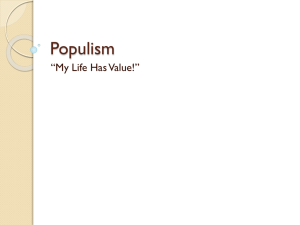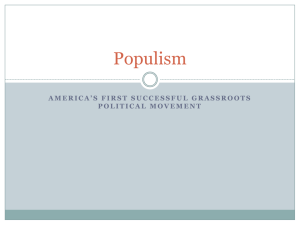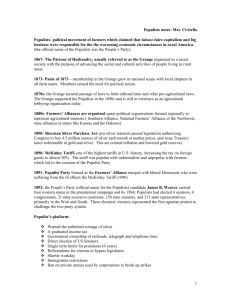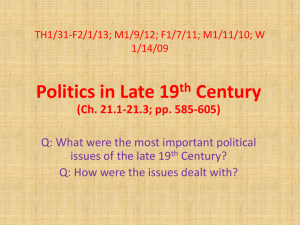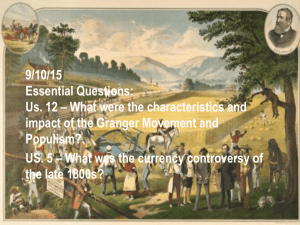Major Concept 3: Gold Standard vs. Bimetallism Terms/People: William Jennings Bryan &
advertisement
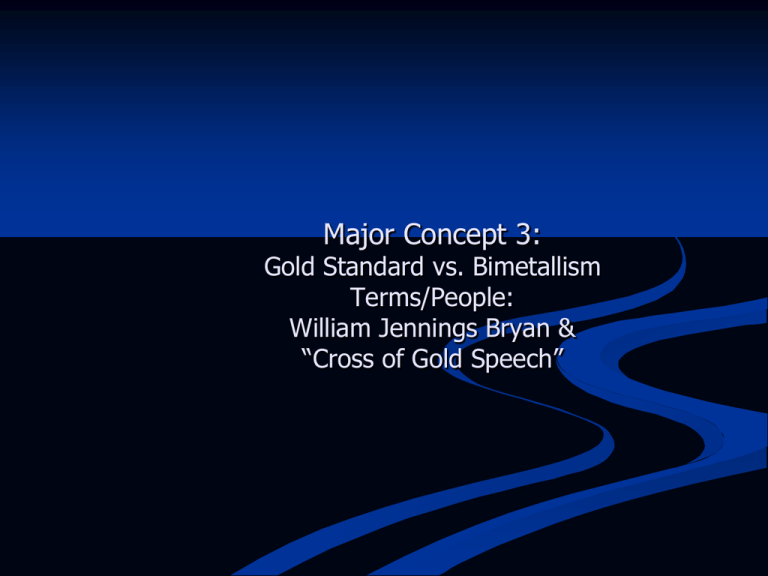
Major Concept 3: Gold Standard vs. Bimetallism Terms/People: William Jennings Bryan & “Cross of Gold Speech” The Gold Standard “The gold standard is a monetary system where a country's currency or paper money has a value directly linked to gold. With the gold standard, countries agreed to convert paper money into a fixed amount of gold. A country that uses the gold standard sets a fixed price for gold and buys and sells gold at that price. That fixed price is used to determine the value of the currency.” Visit this page and read about bimetallism http://projects.vassar.edu/1896/currency.html The U.S. stopped using the Gold Standard in 1971. Bimetallism Is the use of both gold and silver as money Farmers (wheat and cotton) thought Bimetallism to be very beneficial to them Silver miners in the west approved of Bimetallism to ensure the value of silver. Bimetallism caused much controversy Was the topic of political debates 1896 and 1900: Gold Forces/Republicans/William McKinley “Silverites”/Democrats/William Jennings Bryan McKinley defeats Bryan William Jennings Bryan Gave “Cross of Gold Speech” National Democratic Convention July 9, 1896 Visit this page http://historymatters.gmu.edu/d/5354/ Ran for president 3 times “The gold standard has slain tens of thousands.” The Wonderful Wizard of Oz Symbolizes Bimetallism In the original book: yellow brick road: gold Traveled the road with silver slippers In 1939, the movie changed the silver slippers into ruby slippers. Dorothy leads: Scarecrow: Farmers Tin Woodman: Workers Cowardly Lion: Politicians Goal is to see the Wizard (President) in Oz (Oz. = Ounce) Munchkins: the “little” people Wicked Witch of the West: Giant Corporations (the enemy) Dorothy defeats the Witch: Progressives tried to defeat the Corporations Quiz Who gave the “Cross of Gold” speech? What is the Gold Standard? What is Bimetallism? Who approved of Bimetallism? “The gold standard has slain tens of thousands” was said by _____________. The Wonderful Wizard of Oz represents ___________. The original slippers worn by Dorothy were ________. Sources: http://conservapedia.com/Bimetallism http://www.investopedia.com/ask/answers/09/goldstandard.asp#ixzz1pUECsdSj Populism Political Cartoons Populists' major complaint was that politicians and Wall Street held the "people" down by manipulating the political system. This problem could be solved by a "rising of the people" that would restore popular control of government. Farmers and laborers (especially miners) proved to be the Populist Party's strongest supporters. In this cartoon, the fruits of their labor are being stolen by financial interests through foreclosures, interest, rents, etc. Populists defended the original meaning of America -- a place where relatively equal small producers dominated. Monarchy, aristocracy, and other forms of privilege constituted a negative counter-image to American republicanism in Populist eyes The caption at the bottom of this cartoon reads: George Washington (Farewell Address) -"We should look to the future for a power not of the people (plutocracy) may seek to destroy this free government. Eternal vigilance is the price of liberty." Thomas Jefferson (Democrat 1801) -- "All men being created free and equal, it is therefore a fundamental principle of this government to guarantee equal rights to all and special privileges to none." Abraham Lincoln (Republican 1860) -- "A government by the people, for the people and of the people shall not perish from the earth." Plutocracy (1896) -- "Them fellows were foolish to believe that they could keep me off this throne." Populists opposed the rising gap between rich and poor that developed during late nineteenth century America. Talent and hard work alone could not explain the differences. Thus, Populists suspected that the rich had gotten ahead through illegitimate special privileges. Populists feared that concentration of wealth would destroy the economic independence that Americans needed to be political free agents. European-style monarchy constituted the major threat to America's democratic institutions during the nineteenth century. Populists argued that all value came from the physical labor involved in creating a product. This is called the labor theory of value. Landlords and other exploiters were viewed as obtaining their wealth illegitimately. Farmers particularly complained about middlemen profits. According to the labor theory of value, middlemen were exploiters rather than producers. Populists claimed that Democratic and Republican politicians agitated meaningless issues, such as tariff revision, in demagogic attempts to divert people's attention from the real problems that producers faced. Mainstream politicians, in turn, were controlled by special interests (particularly financial interests), according to Populists. In this illustration, Christ, who overturned the money changers tables in the house of the Lord, evicts financial interests from Congress. Populists leaders believed that once people had been educated as to the causes of their plight they would join the People's Party. The Southern Farmers Alliance (which spread throughout the South in 1886 and to the Plains States and West about 1890) was a forerunner of the Populist Party. Educating farmers in the politically neutral Southern Farmers' Alliance setting was crucial to building the People's Party. Late 19th century politics was highly partisan and loyalties were strong. Direct appeals from partisans of another party usually were dismissed without much of a hearing. The Farmers' Alliance became a valuable way-station between a voter's old party and Populism. The Farmer’s Alliance is represented in the center, flanked by a Republican Politician and a Democratic Politician. Populist cartoonists loved to use the "enemy's" own words against them. In 1891, the People's Party replaced Republican John J. Ingalls with farm editor William A. Peffer as U.S. Senator from Kansas. Populists saw their party as a tool for bringing relief to the laboring masses. "NonInterest Bond" was a euphemism for greenbacks (paper money not backed by silver or gold), which Populists advocated. The People's Party nominated ex-Union Gen. James B. Weaver and ex-Confederate Gen. James G. Field for for president and vice president in 1892. The Blue-Gray ticket symbolized the Populist attempt to overcome the Civil War and Reconstruction animosities that Democrats and Republicans had employed to maintain loyalty to their parties. The 1892 Omaha Platform of the People's Party quickly became the Bible of Populism. The land, transportation, and money planks formed a trinity of the party's most important issues. Here, the land speculator is portrayed as the source of poverty and crime among those he has dispossessed. The Omaha Platform called for government ownership of railroads, telephones, and telegraphs. The preamble to the platform stated that "the railroad corporations will either own the people or the people must own the railroads." Populists believed that the power monopolies conferred upon their owners constituted a threat to American liberties. Money proved to be the Populist Party's most important issue. Late nineteenth century America suffered massive deflation. This particularly hurt debtors, like farmers in the South and West. Populists called for both greenbacks and "free silver" as anti-deflation measures. Populists looked to three events that rigged the monetary system against debtors -establishment of the National Banking System in 1863, removal of silver dollars from the list of coins to be minted in 1873, and repeal of the Sherman Silver Purchase Act in 1893. The Omaha Platform called for abolition of the National Banking System (which allowed bankers to control monetary policy) and establishment of government-operated Postal Savings Banks. As an electoral strategy, Populists attempted to form several coalitions. The southern and western sections of the nation had similar debtor economies. Inhabitants believed that railroads and northeastern financial interests unfairly exploited them. Civil War and Reconstruction animosities were the most important obstacle to cooperation between these sections (the West was settled mostly by northerners). Still, this proved to be the Populist's most successful coalition. Populists also contended that farmers and laborers common status as producers made them natural allies. Here, members of the Knights of Labor, Farmers Alliance, and other similar organizations rally together. This coalition worked well in the South and West where both groups largely came from the same ethnic group. The party appeared to make some headway in the heavily-ethnic Northeast and Midwest in the mid-1890s. Populists also called for cooperation between impoverished black and white southerners. Racism was the biggest obstacle. The Democratic Party was the contemporary party of racism and used the issue unmercifully to maintain its dominance of southern politics in the 1890s. The most important impediment to all American third parties has been the argument that voters who leave their old party are only throwing the election to the other mainstream party. Because the argument probably swayed many voters, Populist sentiment almost certainly was greater than voting for the People's Party indicated. Shortly after Grover Cleveland became president in 1893, America's second worst depression began. At its worst, between 15%-20% of the work force was unemployed and many farm products sold for less than the cost of production. Many considered President Cleveland's response to be inadequate. John G. Carlisle (holding the bull's tail) was Cleveland's Secretary of the Treasury. Northeastern financial interests (and politicians) convinced President Cleveland that a decline in investor confidence had caused the Panic of 1893. The problem, they claimed, was an outflow of gold in foreign exchange payments caused by the Sherman Silver Purchase Act of 1890. Cleveland promptly forced repeal of the Sherman Act, which made the free (untaxed) and unlimited coinage of silver at a ratio of 16 to 1 (the pre-1873 ratio) the biggest political issue of the era. Repeal probably caused even greater deflation. Repeal of the Sherman Silver Purchase Act was highly unpopular in the South and West. Although many Democrats and Republicans in the regions favored "free silver," only the People's Party had endorsed the measure in its 1892 platform. Populists expected the "free silver" issue to spur major growth in their party and began to emphasize it. After repeal of the Sherman Silver Purchase Act, the Cleveland Administration floated a bond issue. Populists charged this was a conspiracy to enrich favored classes, especially English investors. As the Panic of 1893 deepened, faith in the Cleveland Administration's anti-depression measures declined, and Populist sentiment grew. Unemployment, labor conflict, and destitution were rampant by 1894. Many believed that apocalypse was near. As "free silver" became the biggest issue of the era, Populists expected to benefit from repeal of the Sherman Act. In this cartoon, the Democratic and Republican parties are portrayed as Cinderella's two ugly sisters. Even with the reduced voter turnout of an off-year election, the Populist vote increased by more than 40% in 1894. Democratic party losses were catastrophic. But, the Republican Party actually gained control of the U.S. House of Representatives with this election. The small Populist contingent held the balance of power in the Senate. With the 1894 Congressional elections, the Democratic Party collapsed in the West. The Republican Party did the same in the South. The People's Party became the main opponent to the dominant mainstream party in both sections. A fluid three-way political struggle for power seemed probable for the all important 1896 general election. Reformers believed that a major shift in the American political and economic system was imminent in 1896. Many believed that a coalition of reformers under the People's Party banner could win the crucial 1896 election. Populists decided to hold their national convention after those of the Democratic and Republican parties in 1896. They hoped to pick up the support of those disenchanted with their old party's pro-gold stance. Republicans predictably nominated William McKinley for president and endorsed the gold standard. Democrats, however, bolted from Cleveland's dominance and nominated William Jennings Bryan for president on a "free silver" platform. This left Populists with little choice but to support the Democratic nominee, or split the pro-silver forces. Populists generally fell into two groups: fusionists and middle-ofthe-roaders. In 1896, fusionists (mostly westerners) wanted unite pro-silver forces and form a coalition with William Jennings Bryan and the Democrats. Midroaders (mostly southerners) opposed veering off the road to reform for expedient coalition victories and advocated a straight Populist ticket. Bryan's Democratic running mate, Arthur M. Sewall, was a banker and capitalist from Maine. This made him particularly obnoxious to Populists, and gave mid-roaders a strong argument against endorsing the Democratic ticket. In the end, the People's Party nominated Bryan for President and Populist Thomas E. Watson for vice president. It looked like a compromise, but really pleased very few. Bryan, The Democratic/Populist candidate for president lost a close race in 1896. The People's Party declined rapidly after (perhaps during) the campaign. One reason was the severe split between fusionists and mid-roaders. This division broke the most successful of Populism's three electoral coalitions (westerners and southerners). After 1896, the two groups held separate conventions and the People's Party spent most of its energy on internal recriminations, which tore the party apart. The return to prosperity after 1896 also played a role in Populism's demise. The People's Party had gained some of its support through criticizing Cleveland's anti-depression measures. This 1898 cartoon suggests the return to prosperity was not as rapid nor as uniform as mainstream politicians claimed. Still, the economic turnaround did help defuse some Populist criticism. The patriotism of the Spanish-American War of 1898 also played a role in destroying Populism. Criticism of the nation's leaders or institutions can be painted as evidence of disloyalty by opponents during wartime. Thus, reformers usually mute their criticism or are silenced during periods of international turmoil. Most Populists probably supported freeing Cuba from autocratic Spanish rule. The United States gained an empire in 1898. Puerto Rico, Hawaii, and the Philippine Islands became possessions, and Cuba became a protectorate. Thus, the U.S. assumed the role of tutelage in the ways of statecraft for these socalled "inferior" peoples. As proponents of the Founding Fathers' anti-colonialism, most Populists opposed imperialism. The nationalistic pride involved in empire building, however, served to mute many reformers. The People's Party did very poorly in the 1898 Congressional elections, and virtually disappeared afterward.

